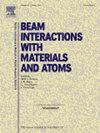Radiation hardness study of liquid scintillator under 80 MeV proton beam irradiations
IF 1.4
3区 物理与天体物理
Q3 INSTRUMENTS & INSTRUMENTATION
Nuclear Instruments & Methods in Physics Research Section B-beam Interactions With Materials and Atoms
Pub Date : 2025-02-04
DOI:10.1016/j.nimb.2025.165628
引用次数: 0
Abstract
For monitoring the 1.6 GeV high-energy proton beam, used in the CSNS Phase II upgrade project, a liquid scintillator (LS) detector has become a viable option due to its excellent radiation hardness and the possibility of exchanging the LS remotely. This work investigates the effects of radiation damage on LS samples based on linear alkylbenzene (LAB) induced by 80 MeV protons. The study includes absorption, fluorescence spectroscopy, and light output measurement of the LS before and after proton irradiation, with a focus on determining the radiation resistance threshold of the LS. The results show that the performance of the LS is not affected at absorbed doses up to 2.44 Gy. This demonstrates its ability to absorb 8.82 p/cm2 1.6 GeV protons and remain stable. This suggests that a detector based on LS could potentially be used for monitoring the high-energy proton beam of 1.6 GeV in the CSNS Phase II Upgrade Project.
80 MeV质子束辐照下液体闪烁体的辐射硬度研究
为了监测用于CSNS二期升级项目的1.6 GeV高能质子束,液体闪烁体(LS)探测器由于其优异的辐射硬度和远程交换LS的可能性而成为一种可行的选择。本文研究了80 MeV质子对线性烷基苯(LAB) LS样品辐射损伤的影响。本研究包括质子辐照前后LS的吸收、荧光光谱和光输出测量,重点确定LS的抗辐射阈值。结果表明,在2.44 × 103 Gy的吸收剂量下,LS的性能不受影响。这证明了它能够吸收8.82 × 1012 p/cm2的1.6 GeV质子并保持稳定。这表明基于LS的探测器有可能在CSNS二期升级项目中用于监测1.6 GeV的高能质子束。
本文章由计算机程序翻译,如有差异,请以英文原文为准。
求助全文
约1分钟内获得全文
求助全文
来源期刊
CiteScore
2.80
自引率
7.70%
发文量
231
审稿时长
1.9 months
期刊介绍:
Section B of Nuclear Instruments and Methods in Physics Research covers all aspects of the interaction of energetic beams with atoms, molecules and aggregate forms of matter. This includes ion beam analysis and ion beam modification of materials as well as basic data of importance for these studies. Topics of general interest include: atomic collisions in solids, particle channelling, all aspects of collision cascades, the modification of materials by energetic beams, ion implantation, irradiation - induced changes in materials, the physics and chemistry of beam interactions and the analysis of materials by all forms of energetic radiation. Modification by ion, laser and electron beams for the study of electronic materials, metals, ceramics, insulators, polymers and other important and new materials systems are included. Related studies, such as the application of ion beam analysis to biological, archaeological and geological samples as well as applications to solve problems in planetary science are also welcome. Energetic beams of interest include atomic and molecular ions, neutrons, positrons and muons, plasmas directed at surfaces, electron and photon beams, including laser treated surfaces and studies of solids by photon radiation from rotating anodes, synchrotrons, etc. In addition, the interaction between various forms of radiation and radiation-induced deposition processes are relevant.

 求助内容:
求助内容: 应助结果提醒方式:
应助结果提醒方式:


